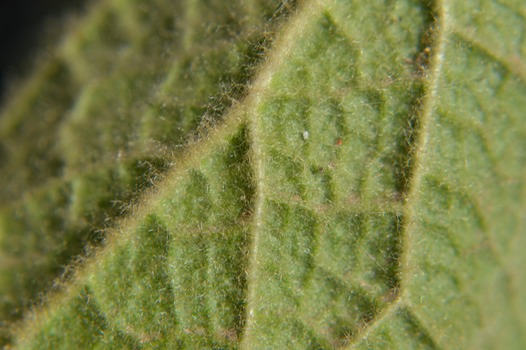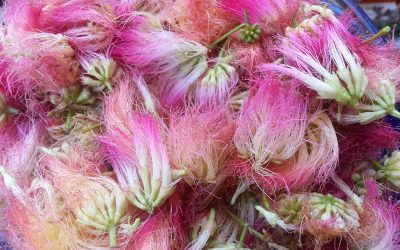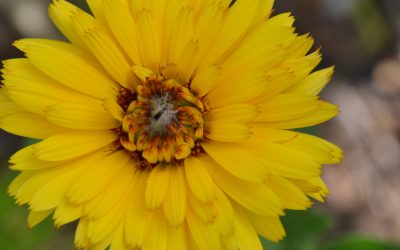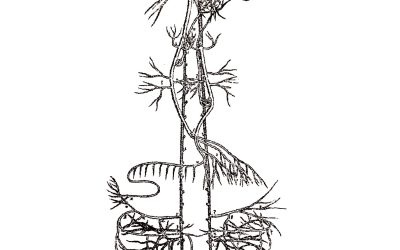Perspective on COVID-19 Home Health Preparations
by Dara Saville
March 22, 2020
Strange times indeed…. Unless we remember that humans have been through similar situations before. In fact, we are the descendants of people who have survived terrifying outbreaks of the past including the H1N1 influenza epidemic of 1918-1919, which infected an estimated 1/3 of the world’s population and killed at least 50 million people. We are the heirs of that resilience and it is time to embody that as we adopt difficult changes in the way we are living our lives and prepare for the possibility of taking care of ourselves and others who may become ill. Every wave of illness that comes through our communities is different and none of us can say with certainty what to do and precisely how to prepare for COVID-19. Unlike our ancestors, however, we have a lot more information available to inform our actions.

Photo: The Motor Corps of St. Louis chapter of the American Red Cross on ambulance duty during the influenza epidemic, October 1918. Source: Centers for Disease Control and Prevention, National Center for Immunization and Respiratory Diseases (NCIRD)
Like other western herbalists writing on this topic, I have no direct experience with this novel virus and am offering a perspective that is based on current and ever-evolving information available about COVID-19 and my knowledge and experience with botanical remedies. I am taking some time away from caring for my own friends and family to share with you what I am doing with the hope that we might all enter into this unknown territory with our inherited fortitude activated and ourselves in a state of readiness for whatever comes our way. The ideas I am offering are supportive for those with experience in herbal practice, who may need to care for people with mild to moderate symptoms at home. This discussion is not intended to replace professional healthcare advice or services and people with more severe symptoms may require hospitalization. Please contact your trusted healthcare provider if you have any symptoms and follow guidelines for COVID-19 testing or quarantine offered by your state.
With so many aspects of our lives upended, many of us are feeling a lack of clarity about how to prepare ourselves, how to help others, and how to handle so much uncertainty. Social distancing or physically isolating is, of course, critically important to reducing our risk of exposure and transmitting COVID-19. Remember that people with no symptoms can still carry and spread COVID-19 and recent studies reported on Harvard’s health website suggest that Corona viruses can remain in the air for up to three hours and live on some surfaces for up to three days. This means staying at home (sheltering in place) or, if possible, taking a break to spend time in wild places where you will not encounter others. I am thankful to live in a place where wilderness is accessible to me at any time, but most especially now. If you have access to wilderness, remember that it is there for you and will help you in ways you might not be able to anticipate. It might even offer you food and medicine, as we discuss below.

Photo: Mullein leaf
There are many self-care rituals that we all know about but may not practice in our normally busy lives or in periods of upheaval. Now is the time to take them seriously and put them into practice.
- Good hygiene including proper hand washing and using hand sanitizer made with 60%+ alcohol can help reduce your risk. Avoid those hand sanitizer recipes calling for vodka or other alcohols that are only around 40%. I make 80% alcohol Juniper (Juniperus monosperma) tincture/liniment/purifying spray to use for a variety of purposes including adding to hand sanitizer, spraying high-touch areas as a disinfectant, clearing the air, and applying directly to myself as a lovely-smelling protectant. You could also do this with Sage (Artemisia) species.
- Remember that healthy eating is one of the most important ways to build your baseline health and nutritive food is what enables our bodies to support healthy immune functioning and so many other critical physiological activities. Spend time at home preparing homemade meals for yourself and others and consider it your first medicine.
- Along those same lines, proper hydration is also essential to your body’s health. COVID-19 is an illness marked by dryness and hydration is especially important for healthy mucus membranes.
- Sleep is another area where many of us struggle to maintain healthy habits. Make time for enough hours of sleep each night and do what is required to maintain good quality sleep. That might mean assuring total darkness of your bedroom, removing phones or other electronics that might disrupt your sleep, or engaging in relaxing mind-clearing activities before bedtime.
- Mitigating stress is always important but especially now. Stress exacerbates health problems but there are many things we can do to process it such as reading enjoyable books, engaging in appropriate exercise, making art, listening to music, meditation, taking walks, or whatever it is we enjoy doing and puts our minds and emotions in another space for respite and realignment.

Photo: Globemallow
With ancestral resilience on our side and our baseline health optimized, what else can we do? We can build our kitchen apothecaries for readiness to care for ourselves, our families, friends, neighbors, or whomever else we may have the honor of assisting in a time of health crisis. I live in the high desert of the Southwest, so my preparations are based on botanical supports from my bioregion. I have included additional links below with other information I have found useful including posts from herbalists I know in other regions.
- Wild Food: Depending on where you live, you will find a variety of nutritive wild foods available to you throughout the seasons. I have other posts on this topic that you may like to read, so I encourage you to browse this blog and see what other posts will serve you in this time. Since it is early springtime, I will recommend the cool season wild crops that are abundant and gatherable in the Southwest right now: London Rocket leaves and flowers (Sisymbrium irio), Wild Lettuce leaves (Lactuca serriola, L. spp.), Cleavers greens (Galium aparine), Dandelion whole plant (Taraxacum officinale), and Siberian Elm (Ulmus pumila) seeds are all abundant already and many others will soon be popping up as the weather warms. If you are a gardener, time to plan your annual crops with a variety of fresh herbs and vegetables suited to your region.
- Immune Herbs: Astragalus (Astragalus membranaceus) is known to improve white blood cell production, thereby supporting immune function in a way that may be particularly useful for COVID-19, as early stage disease has shown a normal to low white blood cell count in lab exams (Cascella et al., 2020). Globemallow (Sphaeralcea spp.) may be one of the most important herbs to have on hand due to its immune-balancing and tonifying effects combined with demulcent (cooling and moistening) properties. It is a widely encountered common herb in the Southwest and S. coccinea ranges across most of the West and into the Plains. It is leafing out now and will begin flowering as soon as the warmer days are more reliable.
- Demulcents: Demulcent herbs may be particularly useful for COVID-19 as it is an illness associated with dryness. Think of plants in the Mallow family, Evening Primrose family, Violets (Viola spp.), Siberian Elm (Ulmus pumila), Licorice (Glycyrrhiza spp.), and Globemallow as mentioned above. Globemallow can be used as a tonic to help remedy dryness while supporting healthy immune functions. Siberian Elm bark can be dried and powdered and steeped in cool water for a few hours to make a gelatinous substance that resembles woody gelatin, which can then be mixed into water, juice, or tea. Licorice root tea or tincture is demulcent and also anti-viral and anti-inflammatory, making it an excellent herb for people without contraindications such as high blood pressure or edema. Also consider having a humidifier and distilled water for your bedroom, especially if you live in a dry climate.

Photo: American Licorice
- Coughing and Respiratory Support: In addition to the demulcents, there are many herbs that could be discussed here but these are my locally abundant favorites. Weedy Mullein (Verbascum thapsus) is easy to find in middle elevation disturbed areas and leaves make a nice lung supporting tea or tincture. Horehound (Marrubium vulgare) leaf tincture is another common weedy remedy known to stimulate fresh lung secretions with new immunological cells and have a relaxant effect on the smooth muscles of the lungs. Red Clover flowers (Trifolium pratense), yet another common weed, have long been used for strengthening the lungs and acting as a moistening anti-spasmodic for dry coughs. Passionflower (Passiflora incarnata), a garden herb in my area, also makes a very nice sedating anti-spasmodic flower tea or tincture for dry coughs and promoting sleep.
- Fever: Fevers are usually a natural expression of healthy immune functioning. If a fever becomes too high or sustained for too long, Yarrow (Achillea millifolium) can be helpful for regulating fevers. If a fever needs to be broken, potatoes have served as my miracle remedy in the past. Applying shredded raw potatoes as a poultice to areas such as the groin, bottoms of feet, forehead, and armpits can rapidly bring heat to the surface where it is released. Yarrow’s diaphoretic action may assist in this process. Note that some medical professionals are recommending avoiding the use of ibuprofen, based on observations.
- Antivirals and Antiseptics: Again there are many herbs that might be discussed here, but my all time favorite anti-viral and lung-supporting herb is Bee Balm (Monarda fistulosa). Prepared as a fresh flower and leaf tincture or an infused honey, it will also provide heat-releasing help for fevers. Although you won’t find this plant flowering until summer, you might have Thyme or Oregano growing in your garden and could use them in this same way. Licorice, as discussed under demulcents, is a potent anti-viral that also reduces inflammation and moistens tissues. Furthermore, there is research demonstrating Licorice’s ability to control viral replication in SARS, a closely related virus to COVID-19 (Cinatl, et al., 2003). Creosote (Larrea tridentata) has a long history of use documented in ethnobotanical literature and supported by modern scientific research for the treatment of severe microbial respiratory illnesses including bronchitis and tuberculosis. Its aromatic properties and traditional uses among native people of its range support its use as a steam treatment for respiratory ailments. The abundant native shrub is already green and vital at this time of year and leafy branches can be collected for this purpose or other preparations.
- Cardiovascular Complications: There is preliminary evidence that COVID may also attack the cardiovascular system degrading the endothelium, reducing oxygenation, and increasing risks of blood clotting. Yarrow tones and tonifies the blood vessels, helps to regulate blood viscosity, and can reduce blood clots. Red Clover builds and cleans the blood while improving blood flow.
- Supplements: If you are not eating as you should, consider taking a multi-vitamin. Also keep zinc and vitamin C on hand to support your body’s response to viral illness. Preliminary findings also support the use of Vitamin D for reducing severity of COVID symptoms.
- Reconsider Drying Herbs: Some herbs that we know and love for many respiratory applications such as Yerba Mansa (Anemopsis californica) or Oshá (Ligusticum porteri) may not be the best suited for COVID-19 due to their natural drying effects. Some lung conditions are benefited by the drying or moving of excess or stagnant mucus and wetness. Since COVID-19 is characterized by a dry cough, other herbs already listed may be better allies. If you choose to use these herbs, make sure to combine them with demulcents.
It is important to remember that there is much we do not know and that we are learning more every day. Recommendations may change as time goes on and our experience with COVID-19 increases. I will update this page as I learn more. While it is imperative that we prepare for the coming weeks, we must also consider the possibility of additional COVID-19 waves. That H1N1 flu pandemic that our forbearers endured came about in three waves: spring 1918, fall 1918, and winter/spring 1919. This is your year for getting to know classic garden herbs, weeds, our most common wild healing plants, and perhaps expanding your garden vegetable plot. Make them part of your life now and let the relationships deepen with each passing year.
View our online herbalism classes for the spring semester.
Other sources of information and assistance with COVID-19:
Harvard Health: https://www.health.harvard.edu/diseases-and-conditions/coronavirus-resource-center
Cascella, Marco, Michael Rajnik, Arturo Cuomo, Scott C. Dulebohn, and Raffaela Di Napoli. “Features, Evaluation and Treatment Coronavirus (COVID-19).” March 8, 2020. Available at: https://www.ncbi.nlm.nih.gov/books/NBK554776/
Cinatl, J. B. Morgenstern, G. Bauer, P. Chandra, H. Rabenau, and H. W. Doerr. “Glycyrrhizin, an Active Component of Liquorice Roots, and Replication of SARS-associated Coronavirus.” Lancet 361, no. 9374 (2003): 2045-6. Available at: https://www.ncbi.nlm.nih.gov/pubmed/12814717
CDC: https://www.cdc.gov/coronavirus/2019-ncov/index.html
WHO: https://www.who.int/emergencies/diseases/novel-coronavirus-2019
Herbal Resources:
https://www.eclecticschoolofherbalmedicine.com/covid-19/
http://7song.com/wp-content/uploads/2020/03/An-Herbalist%E2%80%99s-Notes-the-on-COVID-19-Virus.pdf
Mutual Aid: https://itsgoingdown.org/c19-mutual-aid/
If you live in New Mexico: https://cv.nmhealth.org/



